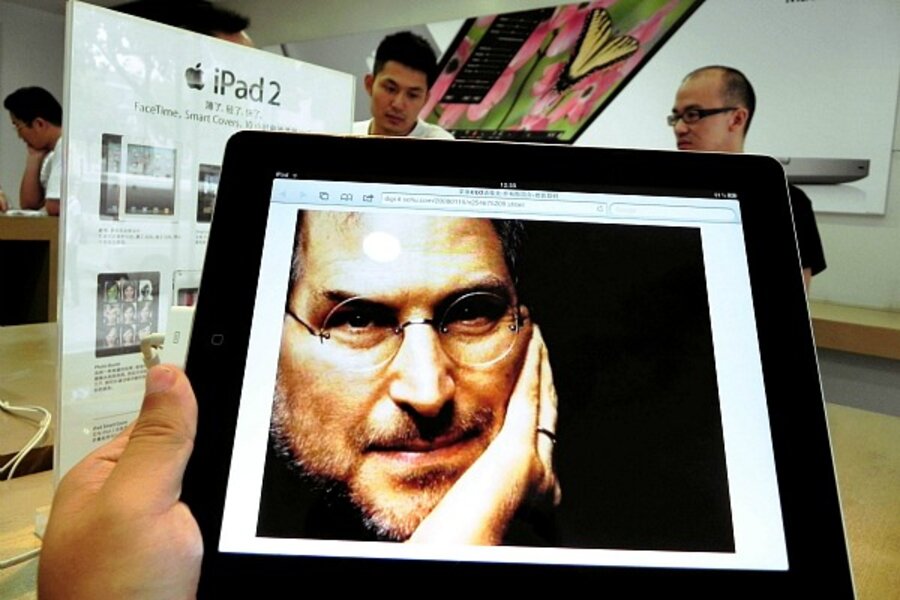Steve Jobs and Apple: How his vision transformed the way we work and play
Loading...
Google “Steve Jobs” and “vision” and you get more than 43 million results.
Surprised, anybody? Apple’s just-resigned CEO has been called the Henry Ford of his generation. Or a cross between Henry Ford and Willy Wonka, as one wag put it. He changed the way of work and play for millions of people, maybe billions.
He launched iToys and iTools and iSoftware, so successful in form and function that his competitors stood in awe and his customers lined up the night before for the latest Apple gadget. Need I mention that when the iPhone was launched it was dubbed the “Jesus phone?”
Now Mr. Jobs has relinquished his role as Apple CEO to company veteran Tim Cook. But he’ll stay on as the company’s board chairman. So depending on his health (apparently the main reason he stepped down), his vision and drive “to put a ding in the universe,” as he once put it, are likely to continue.
Meanwhile, the morning-after blogosphere continues to ricochet with comments about Jobs’s impact and the vision that drove the man and the technology he produced.
“Thanks to Steve Jobs, Apple has had a transformative impact on virtually every technology and service it has touched,” writes Tony Bradley at PCWorld, who pointedly notes that he’s not an “Apple fanboy” and “never owned an Apple computer.”
“Thanks to Jobs’ genius and vision, Apple has transformed not just mobile computing, but personal computing as a whole, with the iPhone, iPad, and MacBook Air. It has transformed media with iTunes, iCloud, and Apple TV,” he writes. “The impact of Apple on technology is evident in small ripples and big waves everywhere you look.”
And it wasn’t just personal iGear that showed Jobs’s genius as a businessman who looked into the future and saw the potential for great success.
During the time he was away from Apple due to an internal company dispute, Jobs bought computer-animation studio Pixar from George Lucas for $10 million, then later sold it to Disney for $7.4 billion in stock. It’s fun to note that one of Pixar’s greatest triumphs during that time was “Toy Story,” which might have been the title of Jobs’s biography, describing a world of cell phones that can also hold thousands of songs, surf the Internet, take photos, and run a zillion apps.
Actually, his story by noted biographer Walter Isaacson (who wrote best-sellers on Benjamin Franklin and Albert Einstein, two other American notables), to be released in November, is titled simply “Steve Jobs.”
“Jobs speaks candidly, sometimes brutally so, about the people he worked with and competed against,” blurbs Amazon. “His friends, foes, and colleagues provide an unvarnished view of the passions, perfectionism, obsessions, artistry, devilry, and compulsion for control that shaped his approach to business and the innovative products that resulted.”
Jobs liked to quote Picasso: “Good artists copy, great artists steal.” And there were times when he may have crossed some notion of business ethics.
At ZDNet, tech writer James Kendrick notes Jobs’s reputation as a hard-nosed businessman unwilling to compromise.
But that, Mr. Kendrick says, is part of his genius.
“If Apple couldn’t produce what his vision dictated, then the product wasn’t released,” Kendrick wrote. “Instead of releasing a compromised product to market, Jobs sent the bright teams at Apple back to the drawing board to make his vision a reality.”
The bottom line for many Jobs-watchers has been in the results.
“Apple makes more devices, at lower cost, with fewer defects than any other firm in the world,” asserts technology writer Farhad Manjoo at Slate. “And it does this year after year, on a schedule so strict we follow it with the seasons (iPhones in the summer, iPods in the fall, iPads in the spring). As a result, Apple can now beat most of its competitors on price and profit.”





